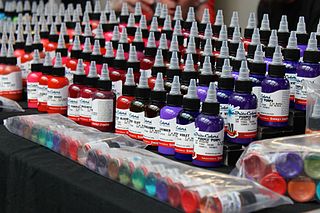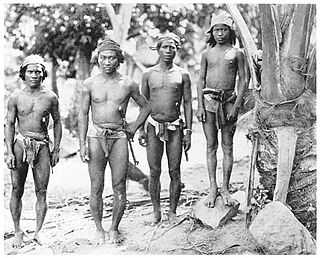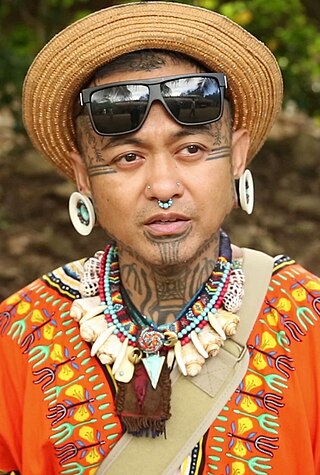
Aleuts are the Indigenous people of the Aleutian Islands, which are located between the North Pacific Ocean and the Bering Sea. Both the Aleuts and the islands are politically divided between the US state of Alaska and the Russian administrative division of Kamchatka Krai. This group is also known as the Unangax̂ (Oo-NUNG-ukh) in Unangam Tunuu, the Aleut language. There are 13 federally recognized Aleut tribes in the Aleut Region of Alaska. In 2000, Aleuts in Russia were recognized by government decree as a small-numbered Indigenous people.

Ötzi, also called the Iceman, is the natural mummy of a man who lived between 3350 and 3105 BC. Ötzi's remains were discovered on 19 September 1991, in the Ötztal Alps at the border between Austria and Italy. He is Europe's oldest known natural human mummy, offering an unprecedented view of Chalcolithic Europeans.

A tattoo is a form of body modification made by inserting tattoo ink, dyes, and/or pigments, either indelible or temporary, into the dermis layer of the skin to form a design. Tattoo artists create these designs using several tattooing processes and techniques, including hand-tapped traditional tattoos and modern tattoo machines. The history of tattooing goes back to Neolithic times, practiced across the globe by many cultures, and the symbolism and impact of tattoos varies in different places and cultures.

Scarification involves scratching, etching, burning/branding, or superficially cutting designs, pictures, or words into the skin as a permanent body modification or body art. The body modification can take roughly 6–12 months to heal. In the process of body scarification, scars are purposely formed by cutting or branding the skin by various methods. Scarification is sometimes called cicatrization.

St. Lawrence Island is located west of mainland Alaska in the Bering Sea, just south of the Bering Strait. The village of Gambell, located on the northwest cape of the island, is 50 nautical miles from the Chukchi Peninsula in the Russian Far East. The island is part of Alaska, but closer to Russia and Asia than to the Alaskan and North American mainland. St. Lawrence Island is thought to be one of the last exposed portions of the land bridge that once joined Asia with North America during the Pleistocene period. It is the sixth largest island in the United States and the 113th largest island in the world. It is considered part of the Bering Sea Volcanic Province. The Saint Lawrence Island shrew is a species of shrew endemic to St. Lawrence Island. The island is jointly owned by the predominantly Siberian Yupik villages of Gambell and Savoonga, the two main settlements on the island.
Maya society concerns the social organization of the Pre-Hispanic Maya, its political structures, and social classes. The Maya people were indigenous to Mexico and Central America and the most dominant people groups of Central America up until the 6th century.

Tattooing has been practiced across the globe since at least Neolithic times, as evidenced by mummified preserved skin, ancient art and the archaeological record. Both ancient art and archaeological finds of possible tattoo tools suggest tattooing was practiced by the Upper Paleolithic period in Europe. However, direct evidence for tattooing on mummified human skin extends only to the 4th millennium BC. The oldest discovery of tattooed human skin to date is found on the body of Ötzi the Iceman, dating to between 3370 and 3100 BC. Other tattooed mummies have been recovered from at least 49 archaeological sites, including locations in Greenland, Alaska, Siberia, Mongolia, western China, Egypt, Sudan, the Philippines and the Andes. These include Amunet, Priestess of the Goddess Hathor from ancient Egypt, multiple mummies from Siberia including the Pazyryk culture of Russia and from several cultures throughout Pre-Columbian South America.

Tattoo inks consist of pigments combined with a carrier, used in the process of tattooing to create a tattoo in the skin. These inks are also used for permanent makeup, a form of tattoo.

The Kalinga people are an indigenous ethnic group whose ancestral domain is in the Cordillera Mountain Range of the northern Philippines. They are mainly found in Kalinga province which has an area of 3,282.58 sq. km. Some of them, however, already migrated to Mountain Province, Apayao, Cagayan, and Abra. The Kalinga numbered 163,167 as of 2010.

The Itneg are an Austronesian ethnic group from the upland province of Abra in northwestern Luzon, Philippines.

The Bontoc ethnolinguistic group can be found in the central and eastern portions of Mountain Province, on the island of Luzon in the Philippines. Although some Bontocs of Natonin and Paracelis identify themselves as Balangaos, Gaddangs or Kalingas, the term "Bontoc" is used by linguists and anthropologists to distinguish speakers of the Bontoc language from neighboring ethnolinguistic groups. They formerly practiced head-hunting and had distinctive body tattoos.

Yup'ik doll is a traditional Eskimo style doll and figurine form made in the southwestern Alaska by Yup'ik people. Also known as Cup'ik doll for the Chevak Cup'ik dialect speaking Eskimos of Chevak and Cup'ig doll for the Nunivak Cup'ig dialect speaking Eskimos of Nunivak Island. Typically, Yup'ik dolls are dressed in traditional Eskimo style Yup'ik clothing, intended to protect the wearer from cold weather, and are often made from traditional materials obtained through food gathering. Play dolls from the Yup'ik area were made of wood, bone, or walrus ivory and measured from one to twelve inches in height or more. Male and female dolls were often distinguished anatomically and can be told apart by the addition of ivory labrets for males and chin tattooing for females. The information about play dolls within Alaska Native cultures is sporadic. As is so often the case in early museum collections, it is difficult to distinguish dolls made for play from those made for ritual. There were always five dolls making up a family: a father, a mother, a son, a daughter, and a baby. Some human figurines were used by shamans.

Whang-od Oggay, also known as Maria Oggay, is a tattoo artist from the village of Buscalan within Tinglayan, Kalinga, Philippines. She is often described as the "last" and oldest mambabatok and is part of the Butbut people of the larger Kalinga ethnic group.

A face tattoo or facial tattoo is a tattoo located on the bearer's face or head. It is part of the traditional tattoos of many ethnic groups.

As in other Polynesian islands, Rapa Nui tattooing had a fundamentally spiritual connotation. In some cases the tattoos were considered a receptor for divine strength or mana. They were manifestations of the Rapa Nui culture. Priests, warriors and chiefs had more tattoos than the rest of the population, as a symbol of their hierarchy. Both men and women were tattooed to represent their social class.

Batok, batek, patik, batik, or buri, among other names, are general terms for indigenous tattoos of the Philippines. Tattooing on both sexes was practiced by almost all ethnic groups of the Philippine Islands during the pre-colonial era. Like other Austronesian groups, these tattoos were made traditionally with hafted tools tapped with a length of wood. Each ethnic group had specific terms and designs for tattoos, which are also often the same designs used in other art forms and decorations such as pottery and weaving. Tattoos range from being restricted only to certain parts of the body to covering the entire body. Tattoos were symbols of tribal identity and kinship, as well as bravery, beauty, and social or wealth status.

Kakiniit are the traditional tattoos of the Inuit of the North American Arctic. The practice is done almost exclusively among women, with women exclusively tattooing other women with the tattoos for various purposes. Men could also receive tattoos but these were often much less extensive than the tattoos a woman would receive. Facial tattoos are individually referred to as tunniit (ᑐᓃᑦ), and would mark an individual's transition to womanhood. The individual tattoos bear unique meaning to Inuit women, with each individual tattoo carrying symbolic meaning. However, in Inuinnaqtun, kakiniq refers to facial tattoos.

Scarification in Africa is a major aspect of African cultures and cultural practice among African ethnic groups; the practice of scarification in Africa includes the process of making "superficial incisions on the skin using stones, glass, knives, or other tools to create meaningful pictures, words, or designs" and expresses "clan identity, status within a community, passage into adulthood, or spiritual significance."

Elle Festin is an American tattoo artist of Filipino origin. In 1997 he created the Tatak ng Apat na Alon tribe, a transnational
Tatak Ng Apat Na Alon Tribe or Mark of the Four Waves tribe in English, is a transnational collective made up of members of the Filipino diaspora who work to preserve the ancestral traditions of Filipino tattooing. It was founded in 1996 in Los Angeles by tattoo artist Elle Festin.


















